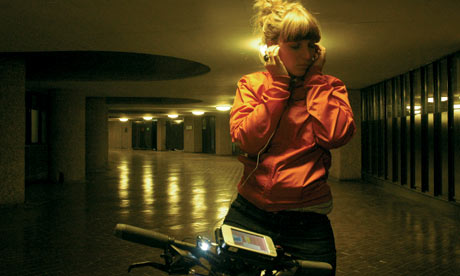
Is the internet good or bad for the theatre? Does it provide exciting opportunities for interactivity that should be exploited? Or, as in the case of Twitter, does it only serve to further reduce our attention spans and our ability to connect with anything that needs to be said in more that 140 characters? These are the questions bloggers are exploring this week. For Lyn Gardner, the web certainly holds enormous promise and potential for theatre-makers. In a recent post on this blog, she argued that "the growth of pervasive media and digital technologies is offering theatre-makers and audiences unprecedented new challenges and opportunities".
Yet not everyone is so convinced. George Hunka recently came across this article in the New York Times by Michiko Kakutani about the effect of the web on our ability to appreciate art. Kakutani suggests that the rise of the net has helped create a culture with attention-deficit disorder in which people will "tweet and text one another during plays and movies, forming judgments before seeing the arc of the entire work". And where the constant feedback demanded by interactive technology can, in effect, become like a "giant focus group" that challenges "the autonomy of the artist".
Hunka shares this cautious scepticism towards cyber-interactivity. "Internet users," he says, "seem to be a jumpy lot, demanding the instant gratification that is denied by more complex art of any kind. It is a call for an increased shallowness in some ways, and these digital and virtual connections, it must be remembered, are digital and virtual, not particularly human."
Yet perhaps the real issue the internet poses for artists is that, as 99 Seats suggests, it forces them to work harder. "Audiences," he argues, "are smart ... They see plot twists coming a mile off. They know tropes and devices the instant they appear and are rarely fooled … Too often, in theatre, they're getting the same old slop; even when it's postmodern slop, [they] see where it's going and would rather engage in something that engages them back. If someone is texting or Twittering during your show, maybe – just maybe – it's not them. It's you."
Of course, interactive art is not just confined to the virtual reality of the web; it can also flourish in the concrete reality of the city. At its best, it can traverse the two. Theatre-maker Tassos Stevens was recently in Tokyo for the British Council's Connected festival, where he took part in a panel discussion about how we make art in the city. He posts his notes from that discussion on his blog, and they provide an excellent insight into how the real and virtual worlds can be combined.
Stevens's company, Coney, creates events that are "about the audience. We often talk to them using digital technology to bring them into the story wherever they are. Digital infrastructure means that we can bring people to work that is happening in any place." And once they have gathered people in this way they can then work to transform their audiences' view of their surroundings. To illustrate this, he describes one project that took participants on an adventure through and around the National Theatre: "By having an adventure in the building about the building, we could transform the way people felt inside that place and the way they perceived the building."
Andy Field, who also took part in this discussion, gives another example of how the virtual world can be used to transform our view of the real world. He cites the work of the company Blast Theory that "often examines our relationship to new digital technologies in the city. GPS tracking devices, mobile phones, the internet. Their art asks its audience to reconsider their relationship to these everyday technologies. In Rider Spoke, the matrix of isolated Wi-Fi networks arrayed across the city are repurposed as a way of building up a map of memories and experiences."
Arguably, in both of these examples, the audience is being asked to work much harder, and concentrate much more than they would in more traditional pieces of theatre. So perhaps, ultimately, we should avoid looking at the net as either intrinsically good or bad. Rather, we should see it as a tool, and like all tools, it is only as good as the person or people using it.

